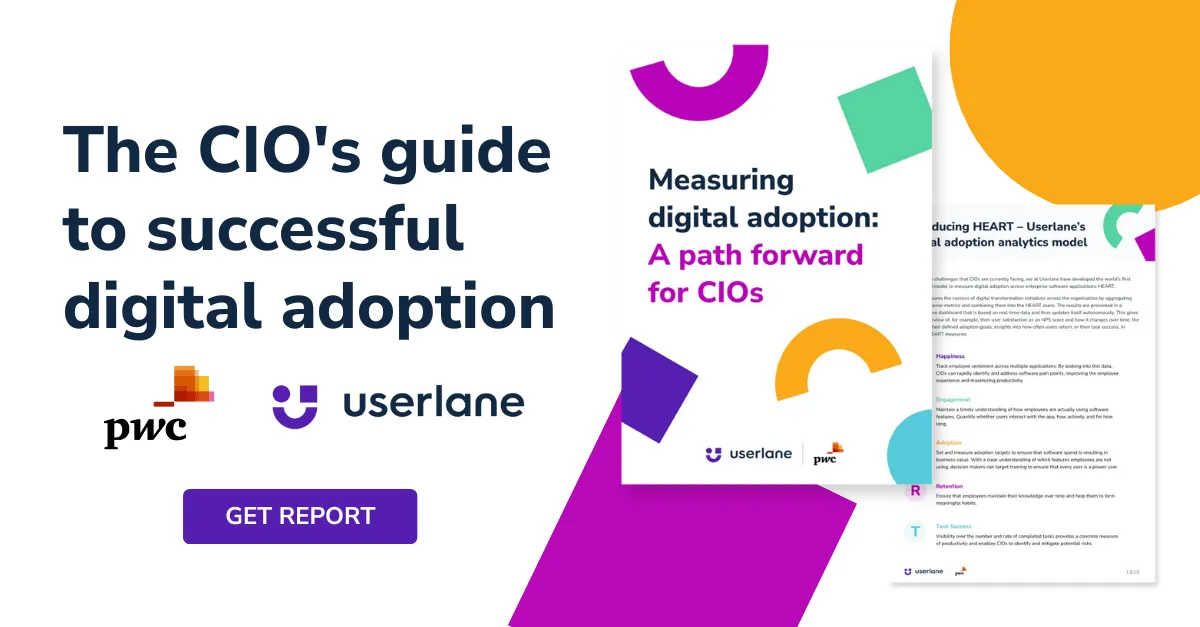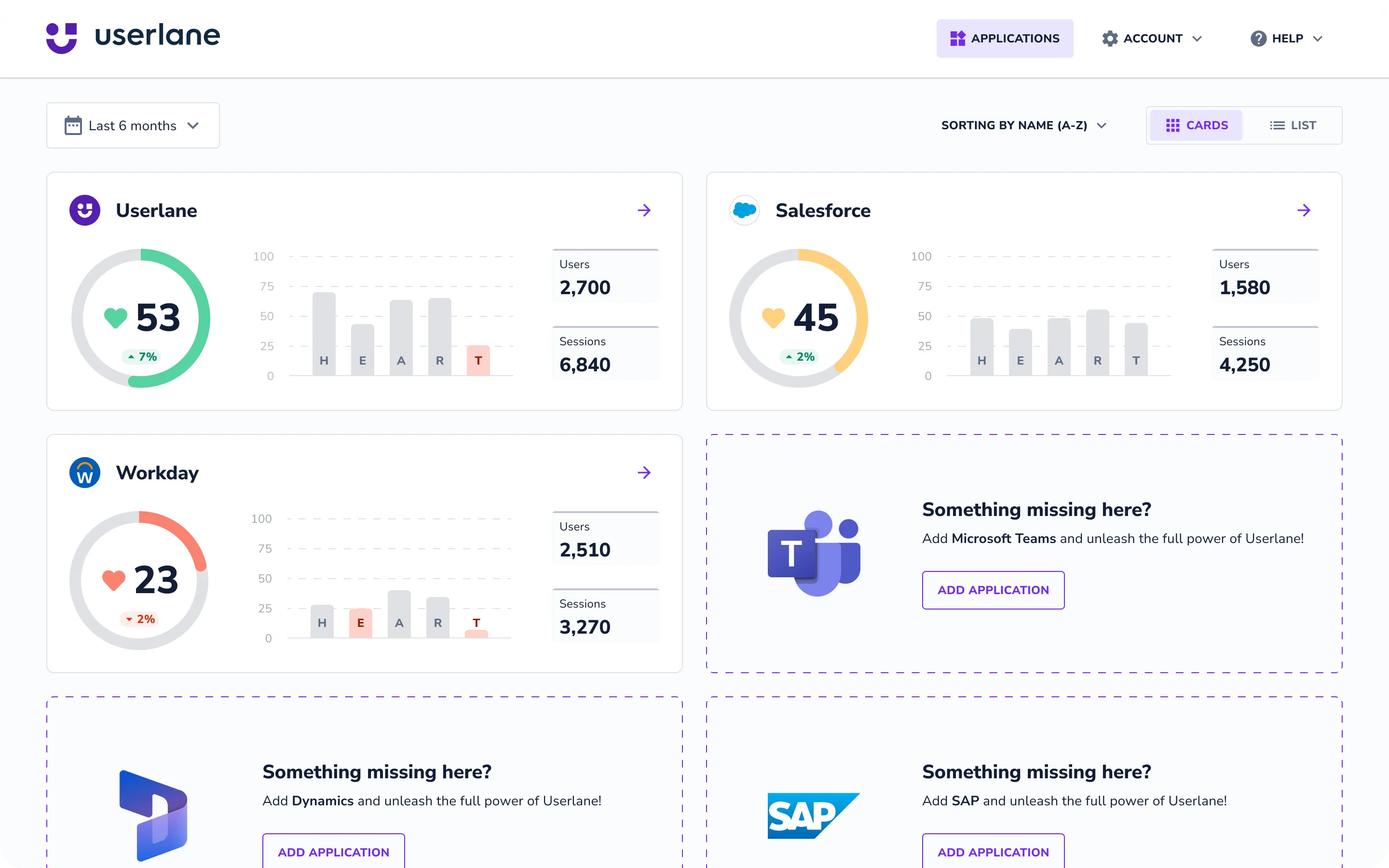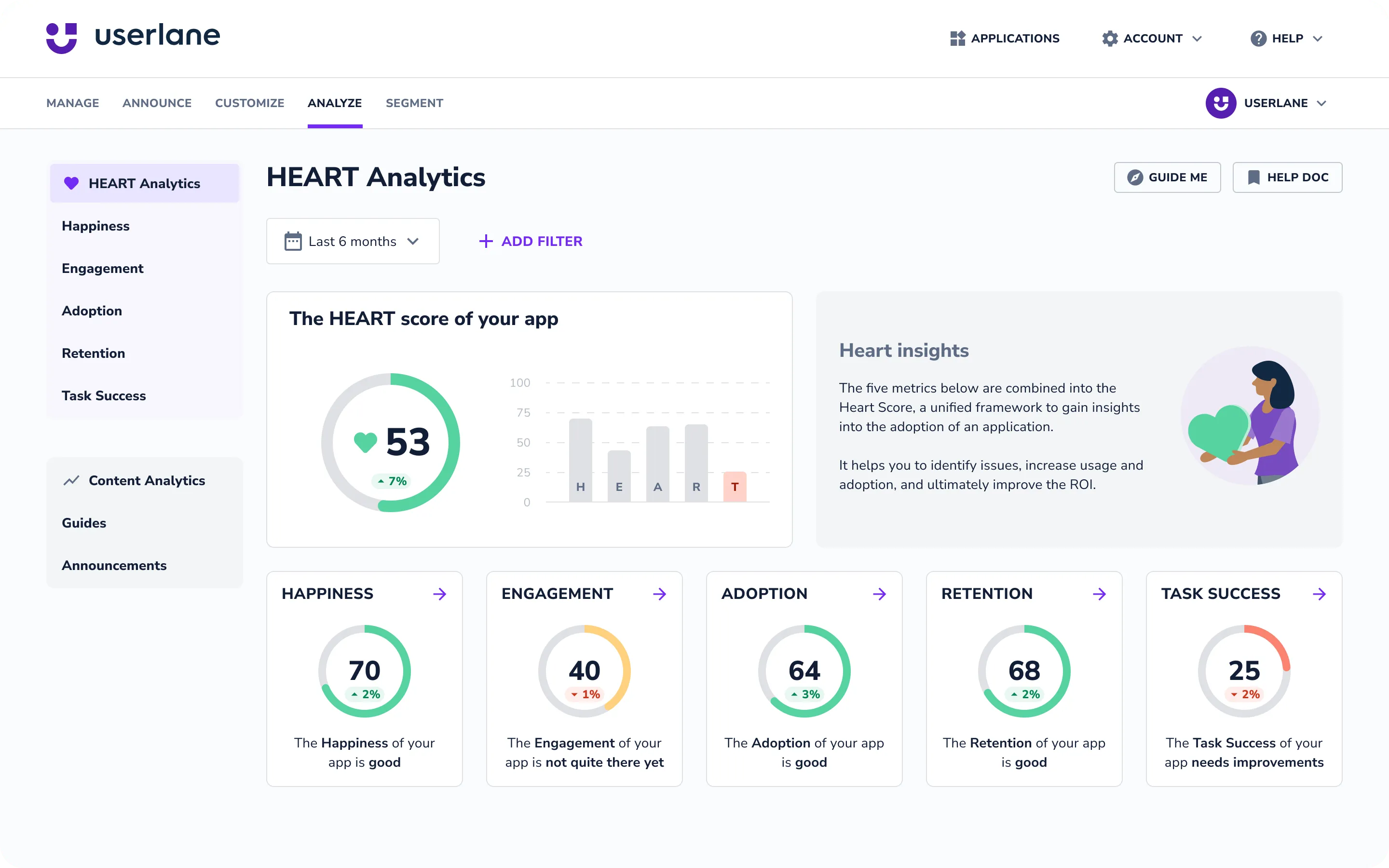Company News and Press Releases
The HEART analytics framework explained

by
Team Userlane
2 years ago ・ 2 mins We speak with CIOs and IT leaders all the time, and two major pains come up time and time again: First, they have no single view to track the adoption of all of their applications across the organization. It’s tough because while these apps often come with some form of instrumentation or usage analytics, the quality, thoroughness and accessibility of this varies quite a bit from vendor to vendor. To combat this we see a lot of data exports, pushing things into third party BI tools, and even excel spreadsheets, with expensive data teams working overtime just to get the most basic information in the hands of the people who need it. Second, they spend a lot of time trying to establish a model, or framework, for measuring success of digital adoption and transformation. Knowing what good looks like, then measuring that easily across your entire organization, isn’t easy. Time and again we see IT leaders failing at this, and falling back onto vanity metrics that aren’t really actionable, and that don’t really give you an idea of what you need to do next. Userlane’s HEART establishes a consistent framework, for the first time ever in a Digital Adoption Platform. And the multi-app view, which I call the CIO view, shows you all your apps on one page with their full HEART score and trend, so you instantly know where you need to focus your efforts.
We speak with CIOs and IT leaders all the time, and two major pains come up time and time again: First, they have no single view to track the adoption of all of their applications across the organization. It’s tough because while these apps often come with some form of instrumentation or usage analytics, the quality, thoroughness and accessibility of this varies quite a bit from vendor to vendor. To combat this we see a lot of data exports, pushing things into third party BI tools, and even excel spreadsheets, with expensive data teams working overtime just to get the most basic information in the hands of the people who need it. Second, they spend a lot of time trying to establish a model, or framework, for measuring success of digital adoption and transformation. Knowing what good looks like, then measuring that easily across your entire organization, isn’t easy. Time and again we see IT leaders failing at this, and falling back onto vanity metrics that aren’t really actionable, and that don’t really give you an idea of what you need to do next. Userlane’s HEART establishes a consistent framework, for the first time ever in a Digital Adoption Platform. And the multi-app view, which I call the CIO view, shows you all your apps on one page with their full HEART score and trend, so you instantly know where you need to focus your efforts.  The outcome of this is that you can switch on HEART across all your apps, and find out where users are struggling, and why. You can then use the rest of the Userlane toolbox to fix things with Interactive Guides, contextual tooltips, Knowledge Base Search, Announcements, and much more. In short, if you’re a CIO or IT leader, you can take all the guesswork out of your software implementations and take back control of your investments.
The outcome of this is that you can switch on HEART across all your apps, and find out where users are struggling, and why. You can then use the rest of the Userlane toolbox to fix things with Interactive Guides, contextual tooltips, Knowledge Base Search, Announcements, and much more. In short, if you’re a CIO or IT leader, you can take all the guesswork out of your software implementations and take back control of your investments.  Can you tell us more about the process of creating HEART? It all comes down to Userlane’s Guiding Principles, and two in particular: Fight for Simplicity, and Help our Customers Win. We took a look at what large enterprises were using and it was a bit of a mess. A combination of custom BI, various out of the box charts from their apps, and spreadsheets. Lots and lots of spreadsheets. In short, not very Userlane at all. We wanted HEART to have the cleanest user experience possible, but it also had to be useful, with a strong bias towards action and recommendations. It had to be complex, but never complicated. In short, we wanted to take people who don’t have much time and probably aren’t digital adoption experts, and give them something that augmented them, and made them exactly that: digital adoption superheroes. To meet this challenge we brought in the best designers, data scientists and data visualization experts from around the world to work the problem. And we also brought in a huge team of user experience experts: our customers! For the past year we’ve been working closely with dozens of organizations to get this right. It’s now ready for everyone to experience. But we also have exciting plans for what’s happening next, so what you see now really is just the beginning. What advice would you give to enterprises to make the best use of HEART? HEART is designed to help you track, understand and improve digital adoption across your entire organization. The sooner you switch it on, the deeper and more complete your understanding will be of precisely where employees are struggling and where you’re losing efficiency and efficacy in your business, whether it’s related to quality, speed, lack of task success or simply that your users have some feedback on how to make things better. So, in a nutshell, you can’t improve what you can’t see. So switch HEART on across as many of your critical applications as possible.
Can you tell us more about the process of creating HEART? It all comes down to Userlane’s Guiding Principles, and two in particular: Fight for Simplicity, and Help our Customers Win. We took a look at what large enterprises were using and it was a bit of a mess. A combination of custom BI, various out of the box charts from their apps, and spreadsheets. Lots and lots of spreadsheets. In short, not very Userlane at all. We wanted HEART to have the cleanest user experience possible, but it also had to be useful, with a strong bias towards action and recommendations. It had to be complex, but never complicated. In short, we wanted to take people who don’t have much time and probably aren’t digital adoption experts, and give them something that augmented them, and made them exactly that: digital adoption superheroes. To meet this challenge we brought in the best designers, data scientists and data visualization experts from around the world to work the problem. And we also brought in a huge team of user experience experts: our customers! For the past year we’ve been working closely with dozens of organizations to get this right. It’s now ready for everyone to experience. But we also have exciting plans for what’s happening next, so what you see now really is just the beginning. What advice would you give to enterprises to make the best use of HEART? HEART is designed to help you track, understand and improve digital adoption across your entire organization. The sooner you switch it on, the deeper and more complete your understanding will be of precisely where employees are struggling and where you’re losing efficiency and efficacy in your business, whether it’s related to quality, speed, lack of task success or simply that your users have some feedback on how to make things better. So, in a nutshell, you can’t improve what you can’t see. So switch HEART on across as many of your critical applications as possible.  What’s next for Userlane Analytics? Like I said before, we have exciting plans for what’s happening next, so what you see now really is just the beginning of our relationship with HEART. Some of what we’re planning, I can’t go into too much detail right now. But I’m very excited to see advances in the areas of Benchmarking, Personalized Recommendations and Path or Task Analysis. Now that HEART is out there, you’ll also have your own ideas of where you’d like to see it evolve, and we’d love to hear them. So please engage with the team and submit your feedback and suggestions on our public roadmap at roadmap.userlane.com For readers who are thinking wow, I need to check out HEART, how can they do so? We’d love you to check it out too! So please get in touch for a personalized demo with a member of the team.
What’s next for Userlane Analytics? Like I said before, we have exciting plans for what’s happening next, so what you see now really is just the beginning of our relationship with HEART. Some of what we’re planning, I can’t go into too much detail right now. But I’m very excited to see advances in the areas of Benchmarking, Personalized Recommendations and Path or Task Analysis. Now that HEART is out there, you’ll also have your own ideas of where you’d like to see it evolve, and we’d love to hear them. So please engage with the team and submit your feedback and suggestions on our public roadmap at roadmap.userlane.com For readers who are thinking wow, I need to check out HEART, how can they do so? We’d love you to check it out too! So please get in touch for a personalized demo with a member of the team. New to Userlane? Take a step in your software adoption journey and join the pool of our happy customers.
Find more in
About the author:
The Userlane team brings you digital adoption insights, product updates, and plenty of onboarding and engagement advice for user-centric businesses.

